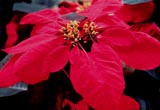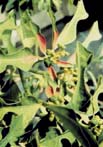|
Figure 8: Dieffenbachia picta, "Dumb cane" |
Several major plant families contain chemical irritants (Table 4). These include crystalline calcium oxalate and a wide range of chemicals dissolved or suspended in plant latex or specific organelles. Some of the more important families with example plants causing chemical irritation are found in the table below.
Table 4. Plants commonly causing chemical irritant dermatitis
|
Family |
Binomial name |
Common name |
Toxin(s)/Location |
|
Amaryllidaceae |
Narcissus spp. |
Daffodil, narcissus |
Calcium oxalate/Stems, leaves, and bulbs |
|
Araceae |
Dieffenbachia picta |
Dumb cane |
Calcium oxalate/Leaves and fruits |
|
Araceae |
Philodendron spp. |
Philodendron |
Calcium oxalate/Leaves |
|
Brassicaceae |
Brassica nigra Raphanus sativus |
Black mustard Radish |
Thiocyanates/ All parts |
|
Bromeliaceae |
Ananas comosus |
Pineapple |
Bromelin/Stem > Fruit Calcium oxalate/All parts |
|
Euphorbiaceae |
Codiaeum variegatum Euphorbia spp. Hippomane mancinella |
Florist's 'croton' Spurges Manchineel tree |
Phorbol esters/Latex in whole plant |
|
Liliaceae |
Hyacinthus orientalis |
Hyacinth |
Calcium oxalate/Bulbs |
|
Polygonaceae |
Rheum rhaponticum |
Rhubarb |
Calcium oxalate/Leaves |
|
Ranunculaceae |
Ranunculus spp. Aqualegia spp. Caltha spp. |
Buttercups Columbine Marsh-marigold |
Protoanemonin/Any freshly-damaged plant parts |
|
Solanaceae |
Capsicum annuum |
Chili pepper, pimentos |
Capsaicin/Fruit |
Calcium oxalate has been found in members of at least 215 plant families. It may be found in any part of the plant in varying concentrations. Cacti can accumulate huge quantities, such as Cephalocereus senilis that contains up to 85% ash weight calcium oxalate! 25 Crystals of calcium oxalate form within plant cells and may aid ionic balance, help remove excess oxalic acid, or protect the plant against foraging animals.25 While calcium oxalate alone can cause irritant dermatitis, it is probably not the sole irritant in plants containing it.
The prototypical calcium oxalate-containing plant is Dieffenbachia picta (Araceae) (Dumb cane, Mother-in-law's tongue). Millions decorate American homes. Common, related plants include Philodendron spp. (Araceae), and rhubarb, Rheum rhaponticum, (Polygonaceae). 'Dumb cane' received its name because chewing the leaves can lead to salivation, burning, mucosal edema, and blisters causing hoarseness or aphonia. Calcium oxalate, a water insoluble salt, is ejected from the plant when exposed to water, as in the skin or mucosa. 15 , 25
|
Figure 8: Dieffenbachia picta, "Dumb cane" |
Bulb dermatitis is less dramatic but more common. Hyacinth, Hyacinthus orientalis (Liliaceae), bulbs contain up to 6% calcium oxalate. Sap from daffodil, Narcissus spp. (Amaryllidaceae), stems causes one of the most common dermatitis in florists, 'daffodil itch.' Dryness, fissures, scaling, and erythema chiefly affect the fingertips, hands, and forearms and are often accompanied by subungual hyperkeratosis. 15 , 25
Calcium oxalate can enhance the irritancy of other chemicals, such as the proteolytic enzyme bromelin found in pineapples, Ananas comosus (Bromeliaceae), by increasing penetration through the stratum corneum. 15 , 28 Pineapple workers often develop cracks, fissures, loss of fingerprints, and microhemorrhages of their hands resulting from juice contact. After the calcium oxalate causes microabrasions, the bromelin exerts its proteolytic effect on dermal blood vessels.25 Treatment of calcium oxalate ingestion includes parenteral steroids, antacid mouthwashes, and analgesics. Antihistamines are of no benefit. The pain and edema diminish over four to twelve days.19
|
Figure 9: Ananas comosus, variegated pineapple |
Many thiocyanates in the Brassicaceae, such as black mustard (Brassica nigra), horseradish (Armoracia rusticana), broccoli (Brassica oleracea v. italica), and radish (Raphanus sativus), cause a spicy taste due to irritant thiocyanates. 'Plasters' made from the plant oils have been used medicinally for years. Unfortunately, prolonged contact causes erythema and blisters.25
|
Figure 10: Armoracia rusticana, Horseradish |
The spurge family (Euphorbiaceae) is notorious for its highly irritant latex, but derives its common name from the purgative properties of its seeds (French 'epurger' - to purge). Latex is made by some seed-bearing plants and refers to the viscid, milky juice used to store hydrocarbons. Over 7000 species of the spurge family are found throughout the world, making it one of the largest families of flowering plants.29 In AD 50, Dioscorides mentioned seven species of Euphorbia as remedies for warts, calluses, and torpid ulcers of the scalp. It seems that wart treatments have advanced little in nearly 2000 years!
The irritant chemicals are found in the milky latex produced by laticifers (distinctive unicellular or multicellular tubes) in the stems, leaves, fruits, and other organs.29 The active chemicals are phorbol (tigliane polyol) esters, caustic diterpene compounds, and/or daphnane (tricyclic diterpenoid) esters; these can also act as cocarcinogens. 15 , 29 The latex may cause a painful, blistering dermatitis and even temporary blindness.29 Different members of this family possess widely variant irritancy potential and even variation among the chemicals comprising the latex. Nearly 2000 years ago, Dioscorides knew first-hand the irritancy of these plants, for in his instructions for mixing cathartic pills he advocated self-protection:30
|
Figure 11: E. esula (latex in stem) |
E. esula |
E. esula (leafy spurge) |
Euphorbiaceae is a large family.29 Some are cultivated as ornamental house plants or border and rock garden perennials.15 Many are weeds. In botanical understanding, a "weed" is a plant that maintains itself in a habitat of continual disturbance. Therefore, weeds thrive in close proximity to man and his domesticated plants and animals.31 More practically, a weed is a plant that interfere's with man's activities or his welfare.31 A weed is a plant growing where it is not wanted, and it interferes with crops, roadsides, landscape plantings, livestock, irrigation ditches, etc. In recent years, the leafy spurge (Euphorbia esula) has invaded Minnesota, Wisconsin, and Michigan, as well as the front range of the Rocky Mountains in Colorado. E. esula will die out in 10-12 years in the absence of disturbances to its habitat. Therefore, the best way to get rid of it is to do nothing! However, 'doing nothing' is impossible in an inhabited area.
Codiaeum variegatum pictum, known as 'Florist's Croton,' is a popular house plant containing a latex that some believe to be irritant, and others, allergenic.29
|
Figure 12: Codiaeum variegatum, Croton |
The castor oil plant (Ricinus communis), another member of Euphorbiaceae that has strangely been called 'true croton' by some, is a very uncommon cause of allergic contact dermatitis. It is now recognized as a cause of chemical irritant dermatitis. 15 , 29
|
Figure 13: Ricinus communis, Castor Bean Plant |
The best known of the Euphorbiaceae, the poinsettia (E. pulcherrina), possesses a latex said to be less irritating than many other family members.29
 |
 |
|
|
|
The most notorious member of the Euphorbiaceae is the 'Manchineel tree' or 'beach apple' (Hippomane mancinella). This tree once grew along beaches from Trinidad to south Florida, but is now mostly restricted to some areas in the Virgin Islands and Everglades National Park. 15 , 29 The tree grows up to 10 m with a spread of 6 m. The whole plant exudes a milky latex when damaged, and the irritant chemicals include daphnane and ingenane orthoesters. The Spanish explorer Oviedo detailed the irritant effects of this tree in 1555 (quoted in Lovell):
"If a man do but repose himself to sleep a little while under the shadow of the same, he has his head and eyes swollen when he rises, that the eyelids are joined with the cheeks. And if it chance one drop or more of dew of the said tree to fall into the eye, it utterly destroys the sight." 15
The latex was once used by Indians as a poison for arrow tips and also as an ingredient in native medicines.17 They were once planted on graves to deter grave robbers, and their juice has been used to brand horses and to blind animals and people.19
Members of the buttercup family (Ranunculaceae) contain the unsaturated lactone, protoanemonin, that is formed after injury to the plant by the breakdown of ranunculin, a glycoside. Contact with the skin causes severe vesiculation and linear streaks that may resemble phytophototoxic reactions. However, there is little or no hyperpigmentation following the immediate reaction. Because protoanemonin rapidly polymerizes to anemonin (a non-irritant), only freshly damaged plants cause a reaction. Buttercup leaves have long been used in Europe and elsewhere as vesicants.16 Native American Indians have used buttercup sap in an astringent ointment for hemorrhoids, in cold remedies, and to revive unconscious people.32
Capsaicin (8-methyl-N-vanillyl-6-nonenamide) and four of its naturally occurring derivatives contribute to the pungent taste of peppers.35 The effect of this chemical is so strong, that even when diluted to one part in 11 million of water, a pungent taste remains.9,36 These fat-soluble phenols comprise 0.02% of the fresh fruit's weight and 0.5-1.0% of the dried fruit's weight.33,36 Virtually all forms of chili peppers are members of the species Capsicum annuum (Solanaceae).33
|
Figure 15: Capiscum annum, Chili Pepper |
Members of the genus Capsicum have been used longer in recipes than any other spice, dating back to 7000 B.C.34 Native Mexican Indians used the irritant smoke from burning peppers as a weapon against invaders.34 Capsicum includes all chili peppers, red peppers, paprika, and the pimentos used in green olives and sandwiches. Capsicum does not include black pepper (Piper nigrum, Family Piperaceae) or the pimento (Pimenta dioica, Family Myrtaceae) used as flavoring in Benedictine and Chartreuse.9, 34, 35 This provides further examples of why we need systematic plant nomenclature instead of reliance on colloquial names.
When applied to the skin, capsaicin depolarizes nerves leading to vasodilation, smooth muscle stimulation, glandular secretions, and sensory nerve activation. Because the nerves, and not the skin itself, are affected, dose-related cutaneous burning pain, irritation, and erythema, but not blistering ensue.33 The pain has been described as a dull ache, like a sunburn, or like an intense, radiating heat, throbbing and prickling, and also as the pain elicited after touching a hot burner.35 These symptoms are often delayed and may last hours to days.35 This problem, known by some as 'Hunan Hand Syndrome' especially occurs among those who prepare their own peppers for eating by roasting them and removing skins from large batches of peppers while they are still warm.34
In New Mexico, the Poison and Drug Information Center receives 60-90 calls per year for 'chili burns' of the hands.35 A controlled study in New Mexico showed that the best home remedy for chili burns was hand-washing with soap and water followed immediately by one hour of immersion in vegetable oil. Cold water was more effective in the first hour of treatment, but it only helped symptoms for as long as involved body parts were immersed. The vegetable oil treated hands were less painful than the cold water treated hands more than one hour after immersion in chili pepper sauce.35 If available, lidocaine gel is anecdotally effective.34, 35 Gloves should be worn while preparing chili peppers to minimize the risk of 'chili burns.'
Medicinal uses of capsaicin include the treatment of post-herpetic
neuralgia, diabetic neuropathy, and arthritis.34
It also serves as the active ingredient in self-defense
sprays.33,
34 Advance to to next page: Phytophotodermatitis
![]()